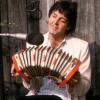
Frank Edgley
Members-
Posts
927 -
Joined
-
Last visited
About Frank Edgley
- Birthday 01/11/1946
Contact Methods
-
Website URL
http://www.concertinas.ca
-
ICQ
0
Profile Information
-
Interests
Concertina maker for over 20 years
-
Location
Windsor, Ontario, Canada
Recent Profile Visitors
7,409 profile views
Frank Edgley's Achievements

Heavyweight Boxer (5/6)
-
Sound cracks by passing a Ventilator
Frank Edgley replied to b13's topic in Instrument Construction & Repair
I definitely does not harm the reeds. -
Parallel vs Radial reed pan (vs everything else)
Frank Edgley replied to LR71's topic in Instrument Construction & Repair
All of these factors, mentioned above, do have effects on tone. The shape of the reed has the greatest IMHO, followed by all the others. I have built concertinas with reed chambers radial and parallel. There is a subtle difference in sound.One is not "better" than the other.....just very slightly different. We're not talking about Stradivarius here. A good tone is a good tone, even if slightly different. Even the best violins made today have different tonal qualities. But these are concertinas. listen to CDs of the best players. They all sound a bit different. Some of it is technique i.e. straight row player or cross row, and there are significant differences among cross row players. Also aggressive vs subtle. And don't forget that concertina tone changes with the the amount of playing, just like most other instruments. -
I admire the knowledge to be able to do this, and understand the functioning etc. But I am not sure why anyone would want to make such an instrument. I know you could make it sound like anything you wanted with such an instrument, but there are other platforms that you can do that already eg. keyboards, Would it only be for the appearance? A concertina that can be made to sound like a trumpet, for example? What's the point? Do that on a keyboard. Sorry if this sounds disrespectful.. That is not my intention.
- 45 replies
-
- 2
-

-

-
- anglo
- electronic
-
(and 2 more)
Tagged with:
-
Troubleshooting leaky action box
Frank Edgley replied to RogerT's topic in Instrument Construction & Repair
Unless I am mistaken, it looks like there is a crack. -
Thank you for the offer. However, it has been sold.
-
Not sure about Tommy McCarthy, as I said in my post, or at least that was my intention. The point I was trying to make was that one system is not better than the other, and my theory as to why a lot of players in Ireland play Jeffries is because it was the best made instrument 40 or 50 or more years ago. Sometimes I have customers say they want a Jeffries system instrument because they heard it is a better system than a Wheatstone/Lachenal. Each system has its advantages and disadvantages, and our fingering patterns evolve according to the pattern of notes on the third row, RH side. I have also heard in the recent past that there is a right way to play (as far as fingering is concerned and what buttons you use to play certain notes) and anything else is the wrong way. There is only a musical way to play. Noel Hill and Chris Droney were very different in their button choices, but were both outstanding players with very different styles and button choices.
-
This is just my take on the issue. I sometimes hear that the Jeffries system of fingering is better that the Wheatstone/Lachenal system, and that is confirmed by the fact that most good players in Ireland play the Jeffries system. First of all, I believe both systems are equal. It all depends what you get used to. You will come up with a fingering pattern you are comforable with, either Jeffries or Wheatstone. So why do so many Irish players play Jeffries system concertinas? I believe it all comes down to the quality of the instrument, historically. Jeffries made instruments were far ahead of Lachenal made concertinas in quality and sound. Wheatstone did not make anglos in any significant numbers, concentrating production on the English system. So if you were a serious player, years ago, you wanted a Jeffries....way better qulity than a Lachenal. This continued until comparatively recently when makers like Colin Dipper and a few others started making excellent quality instruments in both systems. But there is still the legacy of this situation. Excellent players in Ireland give lessons to concertina learners and many, if not most, still play Jeffries. But there have been notable exceptions. Chris Droney played Wheatstone system, and I believe Tommy and Jacqueline McCarthy did as well. So, enough of the idea the one system is better than the other. Personally, I like the Wheatstone/Lachenal system and have based my fingering on it. It's all what you get used to.
-
The owner is willing to accept a lower offer. Make an offer and we will see.
-
I have been asked to find a new home for an Edgley G/D Wheatstone concertina. It is curly maple with metal grills. It uses Voci Armomiche "A Mano" reeds, the best hybrid reeds available, at the time.. The reeds are all screwed down onto leather reed gaskets. This provides an airtight seal and makes the reeds easy to remove for servicing. The button mechanism is as quiet as can be and as fast, and as quiet as even the most skilled players could want. The deep SEVEN fold bellows are in excellent, airtight condition.The finish shows no wear. Nor do the grills. The straps are in good condition. It comes with a padded case. The seller would like $2800, but is willing to negotiate as he, personally, does not play, and is selling the instrument for his brother's widow. Please contact mt at frankedgley@gmail.com for photos and further information.
-
This instrument has been sold
-
Shipping to New York would be no problem. You can call me at 519-991-3100 or email me as above.
-
I just received this yesterday. It is an Edgley C/G Jeffries concertina in mint condition. It has polished stainless grills and is genuine ebony. It has excellent tone and response. Everything, including the bellows, is in mint condition. If you are interested, please send me an email ... frankedgley@gmail.com for other details.
-
What in the world is this?
Frank Edgley replied to Michael Eskin's topic in Instrument Construction & Repair
Concertinas are real instruments, not jokes. -
Tuning piano accordion reeds for Anglo concertina
Frank Edgley replied to Fanie's topic in Instrument Construction & Repair
I would not recommend raising the pitch by filing the tip. It removes too much metal. Lowering the pitch by weighting the tongue is much preferred, ideally by only half a tone. Also, using a metal clip on the tongue, just below the solder point will absorb the heat so you do not spoil the temper of the reed. -
One thing to check would be if the reed shoe has worked loose. This is not unusual with concertinas which use the tapered traditional concertina reeds. You will have to remove the reed pan and check. I saw this happen at the Concertina Festival in Ennis Ireland, last April. Two excellent players had to bring their concertinas to a maker, who happened to be there, before they could play on stage, as a reed had worked loose on their vintage concertinas.






